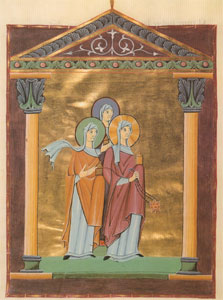Illuminated Reichenau Manuscripts Now Officially Part of Memory of the World
21-10-2004 (Paris)

Illumination from a manuscript at Bayrische Staatsbibliothek, Munich
© Bayrische Staatsbibliothek, Munich
The Illuminated manuscripts from the Ottonian period created in the monastery of Reichenau at Lake Constance in Germany are officially part of UNESCO's Memory of the World Register since last Sunday when Walther Hirsch, President of the German Commission for UNESCO handed over the Memory of the World Certificate.
anuscripts containing the illuminations are held in libraries in Germany (Aachen, Bamberg, Darmstadt, München, Trier), Italy (Cividale del Friuli) and France (Paris). An exhibition on the Reichenau Illuminations can presently be seen at the Bayrische Staatsbibliothek in Munich, Germany.
The book decoration of the monastery of Reichenau, situated on an island in the Lake Constance, epitomizes book illustration of the Ottonian period in Germany. Even though other important centres existed alongside the Reichenau, hardly any other works of art have formed the image of Ottonian art as much as the miniatures which originated there.
After the decline of the Carolingian Empire, political consolidation, the renewal of the idea of the empire and the reform of the church all contributed to a period of cultural rise. During the Ottonian period, German book illustration achieved artistic pre-eminence in Europe for the first time. With sponsorship by the Emperor and influential imperial bishops, the great churches of the empire were provided with priceless equipment and choice manuscripts. The intense intellectual, cultural and religious climate inspired artistic masterpieces. Thanks to commissions from important bishops and the Emperor, the Reichenau had a substantial share in this.
The book illustrations reflect the spirituality of the time, and their ambitions can be inferred from the models which the new art was based on: paintings from Late Antiquity, the Carolingian period and Byzantium. Yet their intention was not imitation, but creative new design.
As one of its outstanding achievements, the book illustration from the Reichenau developed expansive cycles of miniatures on the life of Christ, which were to influence the art of subsequent centuries. Furthermore, the portraits of emperors, which were integrated into the liturgical manuscripts, have received special recognition as works of art and historical sources of the first rank. They express the view of the ruler as protector of the church who was installed by God himself. By adding the ruler's portrait to the book, both his support of the church and his inclusion into prayer are captured visually.
UNESCO's Memory of the World Register, in which the Illuminated Reichenau Manuscripts was included last year, lists documentary heritage that which has been identified by the International Advisory Committee in its meetings in Tashkent (September 1997), in Vienna (June 1999) in Cheongju City (June 2001) and in Gdansk (August 2003) and endorsed by the Director-General of UNESCO as corresponding the selection criteria for world significance.
The book decoration of the monastery of Reichenau, situated on an island in the Lake Constance, epitomizes book illustration of the Ottonian period in Germany. Even though other important centres existed alongside the Reichenau, hardly any other works of art have formed the image of Ottonian art as much as the miniatures which originated there.
After the decline of the Carolingian Empire, political consolidation, the renewal of the idea of the empire and the reform of the church all contributed to a period of cultural rise. During the Ottonian period, German book illustration achieved artistic pre-eminence in Europe for the first time. With sponsorship by the Emperor and influential imperial bishops, the great churches of the empire were provided with priceless equipment and choice manuscripts. The intense intellectual, cultural and religious climate inspired artistic masterpieces. Thanks to commissions from important bishops and the Emperor, the Reichenau had a substantial share in this.
The book illustrations reflect the spirituality of the time, and their ambitions can be inferred from the models which the new art was based on: paintings from Late Antiquity, the Carolingian period and Byzantium. Yet their intention was not imitation, but creative new design.
As one of its outstanding achievements, the book illustration from the Reichenau developed expansive cycles of miniatures on the life of Christ, which were to influence the art of subsequent centuries. Furthermore, the portraits of emperors, which were integrated into the liturgical manuscripts, have received special recognition as works of art and historical sources of the first rank. They express the view of the ruler as protector of the church who was installed by God himself. By adding the ruler's portrait to the book, both his support of the church and his inclusion into prayer are captured visually.
UNESCO's Memory of the World Register, in which the Illuminated Reichenau Manuscripts was included last year, lists documentary heritage that which has been identified by the International Advisory Committee in its meetings in Tashkent (September 1997), in Vienna (June 1999) in Cheongju City (June 2001) and in Gdansk (August 2003) and endorsed by the Director-General of UNESCO as corresponding the selection criteria for world significance.
Related themes/countries
· Memory of the World: News archives 2004
· News Archives of the Memory of the World Register: 2004
· France: News Archives 2004
· Germany: News Archives 2004
· Italy: News Archives
Share this story:














